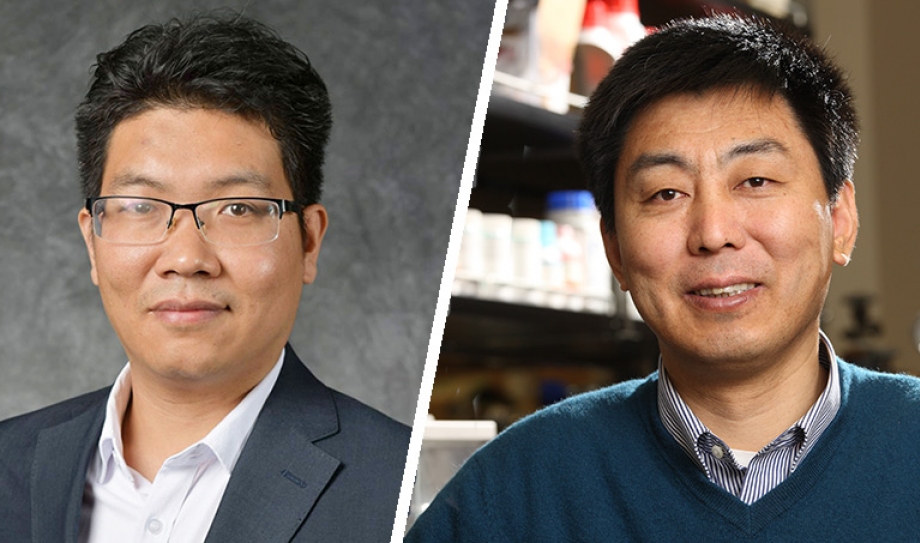Game changer - Smart Nanoparticles
Using nanotechnology, UVA mechanical engineers have developed a game-changing new method for cancer treatment that will likely realize both improved cancer prognoses and reduced side effects from chemotherapy. Their research paper, as part of an international cross-cutting team, was recently published in Nature Communications.
Mechanical Engineering Rolls-Royce Commonwealth Professor Xiaodong “Chris” Li and Ph.D. candidate Zan Gao have synthesized “smart” nanoparticles that can target and infiltrate resilient cancer cells so that chemotherapy drugs can get in to work more effectively. The nanoparticles “disable the shield” of the cell and stop it from “fighting off” chemo treatment. The disabled cell stays inoperative for a window of five days.
“We use specially designed nanoparticles to target mitochondria in cancer cells. Under near-infrared (NIR) laser irradiation, the nanoparticles cause the mitochondria to cut off power to the protective proteinaceous transporters of the cancer cell, the efflux pumps. The dysfunctional efflux pumps turn off the resistance capabilities of cancer cells creating a therapeutic window for chemotherapy,” says Gao. “
Long known in the field as “multi-drug resistance,” researchers have not been able to find an effective way to disarm this formidable barrier, hence treatment windows of five days have been unheard of — until now. Chemotherapy drugs now have ample time accomplish their mission. This radical change in drug transport is expected to advance future treatment efficacy and substantially improve outcomes for patients.

Winning on Multiple Fronts
This particular drug delivery method has even greater merits beyond combatting the cancer cells themselves. Because of the longer treatment window won by the smart nanoparticles, less chemicals are needed to do the job. Less chemotherapy drugs would mean less side effects for the patient. For example, recovery time in between treatments could be reduced. Fatigue, hair loss and anemia could be minimized. Additionally, the surgical strike capabilities of the treatment mean nearby healthy cells are not affected. The patient would not have to endure having civilian cells eliminated in order to be rid of the cancer cells, effectively reducing “collateral damage.” Decreasing toxicity to the patient in multiple ways is an extraordinary and beneficial byproduct of this treatment design.
It Takes Allies
The lead researchers on the project, Professor Li and Professor Xiaoming “Shawn” He from the University of Maryland, have been colleagues for many years. Their professional collaboration is the bedrock that gave rise to this transformative application of nanoparticles.
“Mechanical engineers can’t solve the problem working alone. Biomedical engineers can’t solve the problem working alone. Nor can medical professionals. It takes a real and proverbial handshake, a sit-down-and-brainstorm conversation, maybe ten,” Professor Li quips. “My point is that Dr. He would not have known what I was designing in my lab had it not been for our collaboration, and he wouldn’t have known that the thing I just happen to be developing – a specialized nanoparticle – would offer the solution he’d been looking for on the biomedical side.
New Boundaries
Even before changing the face of cancer treatment, Professor Li’s group had already impacted other areas of science with smart nanoparticle design, including mimicking microstructures found in nature to build lighter, stronger metals, and inventing a wearable supercapacitor and flexible battery.
Now Prof Li and Gao have enlisted a multidisciplinary team at UVA in order to continue their ground-breaking work on cancer treatment, including professors from the School of Medicine (SOM) and the department of biomedical engineering (BME). The UVA team intends to continue to explore the use of different nanomaterials and synthesis processes in order to design an arsenal of nanoparticles with an assortment of sensitivities, selectivities, and functionalities. The team is excited about the prospect of developing more innovations in the engineering-medicine arena.
Gao sums up his enthusiasm, “Nanomaterials bring great hope and possibility to change human life. The smallest particle may possess the power to change the world.”
“In order to make progress in combatting cancer, interdisciplinary collaboration is no longer an option, it’s imperative,” says Li.
In addition to the University of Virginia, the research team consisted of five academic institutions: the University of Maryland, Ohio State University, the University of Missouri School of Medicine, Shanghai University of Traditional Chinese Medicine, and Indiana University School of Medicine.